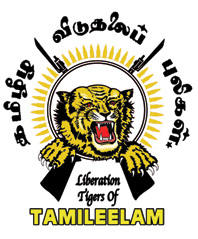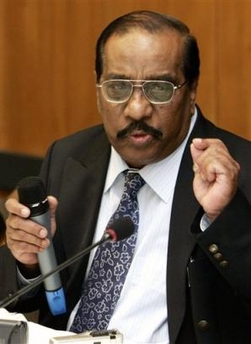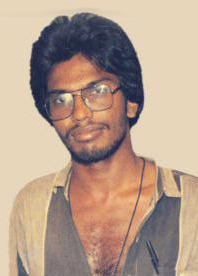Related Research Articles

The Liberation Tigers of Tamil Eelam was a Tamil militant organization that was based in the northern and eastern Sri Lanka. The LTTE fought to create an independent Tamil state called Tamil Eelam in the northeast of the island in response to violent persecution and discriminatory policies against Sri Lankan Tamils by the Sinhalese-dominated Sri Lankan Government.

The Sri Lankan Civil War was a civil war fought in Sri Lanka from 1983 to 2009. Beginning on 23 July 1983, it was an intermittent insurgency against the government by the Liberation Tigers of Tamil Eelam led by Velupillai Prabhakaran. The LTTE fought to create an independent Tamil state called Tamil Eelam in the north-east of the island, due to the continuous discrimination and violent persecution against Sri Lankan Tamils by the Sinhalese-dominated Sri Lanka government.

Velupillai Prabhakaran was an Eelam Tamil revolutionary. Prabhakaran was a major figure of Tamil nationalism, and the founder and leader of the Liberation Tigers of Tamil Eelam (LTTE). The LTTE was a militant organization that sought to create an independent Tamil state in the north and east of Sri Lanka in reaction to the oppression of the country's Tamil population by the Sri Lankan government. Under his direction, the LTTE undertook a military campaign against the Sri Lankan government for more than 25 years.

Maaveerar Naal is a remembrance day observed by Sri Lankan Tamils to remember the deaths of militants who fought with the Liberation Tigers of Tamil Eelam (LTTE) to achieve an independent Tamil homeland. It is held each year on 27 November, the date on which the first LTTE cadre, Lt. Shankar, died in combat in 1982. Traditionally oil lamps are lit for the three days ending on 27 November and the Tamil Eelam flag is raised at ceremonies. The symbol for Maaveerar Naal is the Gloriosa superba which blooms during November.

The Black Tigers was an elite suicide commando unit of the Liberation Tigers of Tamil Eelam (LTTE), a militant Tamil separatist organization in Sri Lanka.

Anton Balasingham Stanislaus was a Sri Lankan Tamil journalist, rebel and chief political strategist and chief negotiator for the Liberation Tigers of Tamil Eelam, a separatist Tamil militant organisation in Sri Lanka.
Gopalaswamy Mahendraraja, also known as Mahattaya was a member of Liberation Tigers of Tamil Eelam who was killed for leaking secrets to India's RAW.

Rasaiah Parthipan was a Tamil Eelam revolutionary and member of the Liberation Tigers of Tamil Eelam (LTTE), a separatist Tamil militant organisation in Sri Lanka. He died while on hunger strike.
The Tamil Eelam Air Force or Sky Tigers was the air-wing of the Liberation Tigers of Tamil Eelam (LTTE), who used it against the Government of Sri Lanka. They also called themselves the Tamileelam Air Force (TAF). Though the existence of the Sky Tigers had been the subject of speculation for many years, the existence of the wing was only revealed after an attack in March 2007, during Eelam War IV.
Eelam War III is the name given to the third phase of armed conflict between the Sri Lankan military and the separatist Liberation Tigers of Tamil Eelam (LTTE).

Eelam War IV is the name given to the fourth phase of armed conflict between the Sri Lankan military and the separatist Liberation Tigers of Tamil Eelam (LTTE). Renewed hostilities began on the 26 July 2006, when Sri Lanka Air Force fighter jets bombed several LTTE camps around Mavil Aru anicut. The government's casus belli was that the LTTE had cut off the water supply to surrounding paddy fields in the area. Shutting down the sluice gates of the Mavil Aru on July 21 depriving the water to over 15,000 people - Sinhalese and Muslim settlers under Sri Lankan state-sponsored colonisation schemes in Trincomalee district. They were denied of water for drinking and also cultivating over 30,000 acres of paddy and other crops. The fighting resumed after a four-year ceasefire between the Government of Sri Lanka (GoSL) and LTTE. Continued fighting led to several territorial gains for the Sri Lankan Army, including the capture of Sampur, Vakarai and other parts of the east. The war took on an added dimension when the LTTE Air Tigers bombed Katunayake airbase on March 26, 2007, the first rebel air attack without external assistance in history.
The Battle of Mullaitivu, also known as the First Battle of Mullaitivu and codenamed Operation Unceasing Waves-1, was a battle between the militant Liberation Tigers of Tamil Eelam and the Sri Lankan military during the Sri Lankan Civil War for control of the military base in Mullaitivu in north-eastern Sri Lanka.
The Northern Theatre of Eelam War IV refers to the fighting that took place in the northern province of Sri Lanka between July 2006 and May 18, 2009.
The 2008–2009 SLA Northern offensive was an armed conflict in the northern Province of Sri Lanka between the military of Sri Lanka and the separatist Liberation Tigers of Tamil Eelam (LTTE). The battle broke with the Sri Lanka Army (SLA) offensive attempting to break through the LTTE defence lines in the north of the island, aiming to conclude the country's 25-year-old civil war by military victory.

Velayuthapillai Baheerathakumar was a leading member of the Liberation Tigers of Tamil Eelam (LTTE), a separatist Tamil militant organisation in Sri Lanka. He played a leading role in the LTTE's military victories in the Vanni during Eelam War III, including Mullaitivu (1996), Kilinochchi (1998), Oddusuddan (1999) and Elephant Pass (2000). He was killed at the Battle of Ananthapuram in the last days of the Sri Lankan Civil War.

The Jeyanthan Regiment was an elite infantry formation of the LTTE. It was founded on 3 May 1993 and was initially trained under the leadership of Colonel Karuna Amman. It was the second oldest and most feared infantry unit of the Tamil Tigers. According to LTTE leader Velupillai Prabhakaran, the Sri Lanka Armed Forces feared the Jeyanthan Brigade the most and sought to avoid direct clashes with them. The soldiers in the unit all hailed from villages in the Eastern Province. Unlike the Charles Anthony Brigade which was only deployed in the North, the Jeyanthan Brigade was deployed in the East as well as the North and played an important role during Second Battle of Elephant Pass. The regiment was named after the LTTE's first Eastern Sea Black Tiger, Captain Jeyanthan, who destroyed a Sri Lankan Naval Patrol Vessel off the coast of Point Pedro on 4 May 1991. Prabhakaran inaugurated the unit on the 2nd death anniversary of Captain Jeyanthan in 1993.

Shanmuganathan Ravishankar was a leading member of the TOSIS, the intelligence wing of Liberation Tigers of Tamil Eelam (LTTE), a separatist Tamil militant organisation in Sri Lanka.

The Battle of Kilinochchi was a land battle fought between the Sri Lankan Military and the Liberation Tigers of Tamil Eelam (LTTE) for control of the town of Kilinochchi in the Northern Theatre of Eelam War IV during the Sri Lankan civil war between November 2008 and January 2009. The town of Kilinochchi was the administrative center and de facto capital of the LTTE's proposed state of Tamil Eelam.
Divisions of the Liberation Tigers of Tamil Eelam refers to the military, intelligence and overseas divisions the Liberation Tigers of Tamil Eelam (LTTE). Most of these divisions were destroyed during the Eelam War IV, and only parts of the intelligence and financing divisions remain overseas.
Iranamadu Airport is an air force station and domestic airport in Iranamadu in northern Sri Lanka. Located approximately 9.5 km (5.9 mi) south east of the town of Kilinochchi, the airport is also known as Kilinochchi Airport and SLAF Iranamadu. Originally built by the rebel Liberation Tigers of Tamil Eelam in 2003, it was captured by the Sri Lankan military in 2009 and taken over by the Sri Lanka Air Force.
References
- 1 2 Sunday Times, Situation Report: SLAF regains its image with powerful strike
- ↑ The Times Online, Tamil Tiger No 2 killed in government air raid
- ↑ "The Government is Creating an Environment for War" - TIME
- ↑ SP Thamilselvan | Obituaries | Guardian Unlimited
- ↑ "The Government is Creating an Environment for War" - TIME
- 1 2 3 "How the SLAF killed the LTTE's "Smiling Cobra" in an air strike". www.dailymirror.lk. Retrieved 13 November 2020.
- ↑ Political Leader of Sri Lanka’s Tamil Tigers Killed in an Airstrike - New York Times
- ↑ Sri Lanka Kills Rebel Leader – TIME
- ↑ Sri Lankan military assassinates LTTE political leader in air strike
- ↑ Associated Press, Tamil Tiger political chief killed in Sri Lanka strike
- ↑ "Thamilselvan widow and children released from custody at Panagoda cantonment"